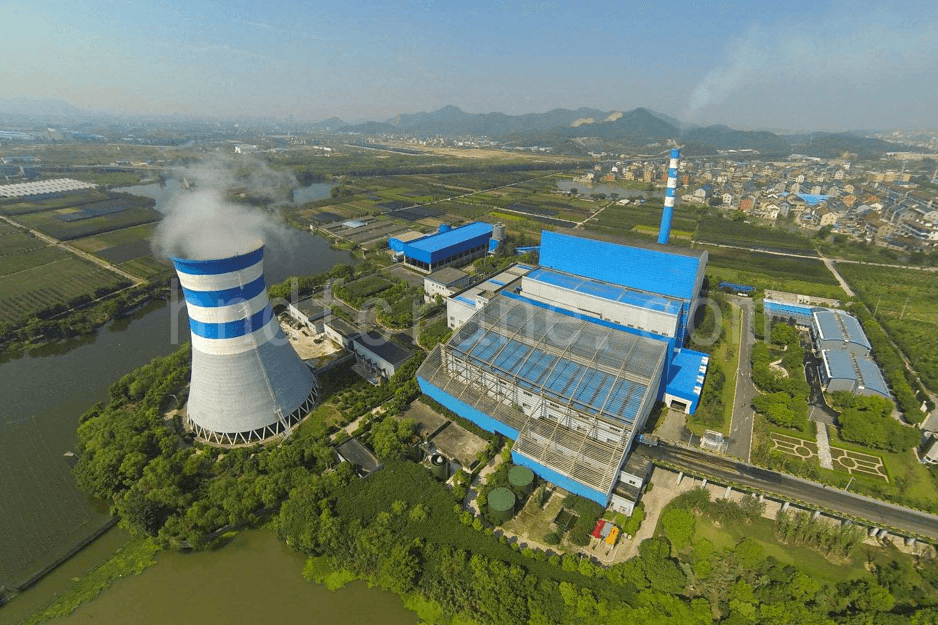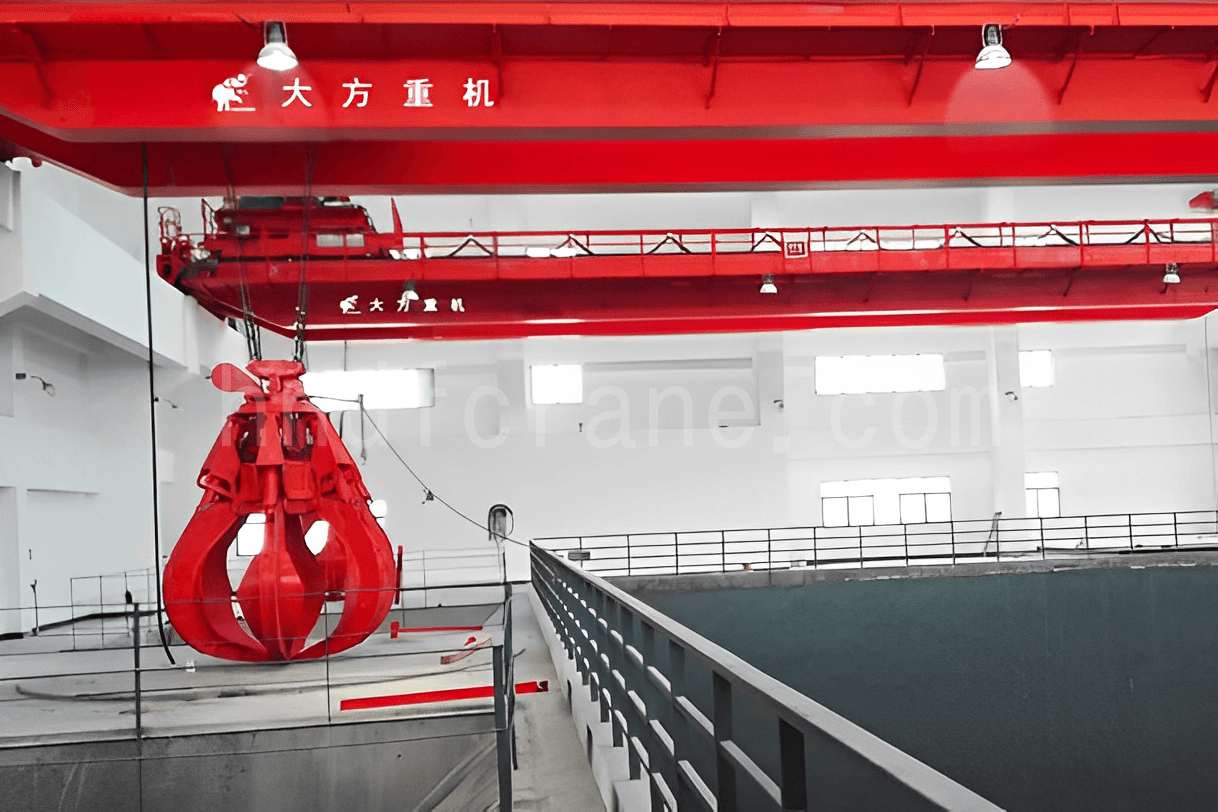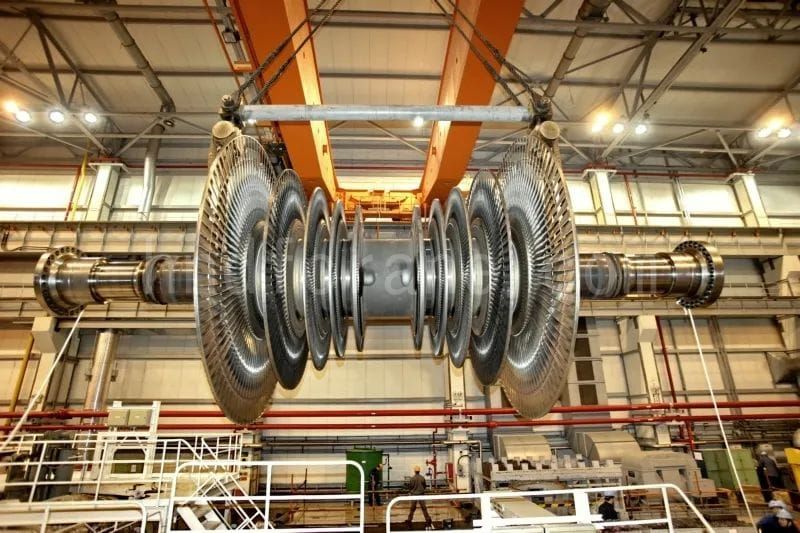폐기물-에너지 플랜트 오버헤드 크레인: 필수 구성 및 선택 가이드
목차
오버헤드 크레인은 자재 취급, 장비 설치 및 유지 관리를 포함한 폐기물-에너지 플랜트에서 중요한 역할을 합니다. 이러한 크레인을 적절하게 구성하면 플랜트의 운영 효율성이 향상될 뿐만 아니라 생산의 안전성과 안정성도 보장됩니다. 수년간의 엔지니어링 실무를 바탕으로 이 기사에서는 폐기물-에너지 플랜트 오버헤드 크레인의 구성과 역할을 살펴보고 전 세계적으로 이러한 시설의 설계 및 운영에 대한 귀중한 통찰력을 제공합니다.

I. 폐기물 에너지화 플랜트의 크레인 기본 구성
폐기물 에너지화 플랜트의 규모는 상당히 다양하며, 하루 300~500톤(t/d)을 처리하는 단일 라인의 소규모 플랜트부터 라인당 750~850t/d를 처리하는 4~6개 라인의 대규모 플랜트까지 다양합니다. 표 1은 기존 프로젝트의 크레인 구성 및 설정을 요약한 것입니다. 고도 데이터는 레일 상단 고도를 나타내며, 효과적인 그랩 버킷 볼륨은 괄호 안에 표시되어 있습니다.
| 아니요. | 두루미 | 기중기 유형 | 작동 모드 | 설치 위치 | 리프팅 용량(그랩 버킷/m³) / t | 근무 의무 | 비고 |
|---|---|---|---|---|---|---|---|
| 1 | 가비지 그랩 크레인 | 더블 거더 그랩 오버헤드 크레인 | 연속, 24시간/일(24 h/d) | 폐기물 구덩이 바로 위, 고도 25~35m | 11(6.3),12.5(8),18(10),20(12) | A8 | 최소 2개의 유닛과 1개의 예비 유닛; 폭발 방지 기능은 필요하지 않습니다. |
| 2 | 애쉬 그랩 크레인 | 더블 거더 그랩 오버헤드 크레인 | 연속, 8~12h/d | 슬래그 구덩이 바로 위, 고도 7~12m | 8(3.2),10(4) | A6~A8 | |
| 3 | 터빈 설치 및 유지 보수 크레인 | 더블 거더 후크 오버헤드 크레인 | 간헐적 | 터빈실 내부, 고도 13~15m | 20/5,25/5,32/5,50/10 | A3 | |
| 4 | 종합 펌프실 유지관리 크레인 | 전기식 싱글 거더 언더슬렁 크레인 | 간헐적 | 종합펌프실 내부, 표고 6~9m | 2~3 | A3 | |
| 5 | 플라이애시 임시저장 유지 크레인 | 전기식 싱글 거더 언더슬렁 크레인 | 간헐적 | 플라이애시 임시보관실 내부 장비 유지관리, 고도 6~9m | 2~3 | A3 | |
| 6 | 워크숍 유지 보수 전기 호이스트 | 전기식 싱글 거더 언더슬렁 크레인 | 간헐적 | 작업장 꼭대기, 고도 6~8m | 2~5 | A3 | |
| 7 | 백하우스 집진기 전기 유지 보수 호이스트 | 전기식 싱글 거더 언더슬렁 크레인 | 간헐적 | 백하우스 집진기 상단에 위치 | 1~3 | A3 | |
| 8 | 가비지 그랩 크레인 유지 보수 전기 호이스트 | 전기 모노레일 크레인 | 간헐적 | 쓰레기 수거 크레인 바로 위, 고도 32~40미터 | 3~5 | A3 | |
| 9 | 유도 통풍 팬 유지 보수 전기 호이스트 | 전기 모노레일 크레인 | 간헐적 | 유도 통풍기 바로 위, 고도 7~10미터 | 5~10 | A3 | |
| 10 | 급수 펌프 유지 보수 전기 호이스트 | 전기 모노레일 크레인 | 간헐적 | 터빈실 급수펌프 바로 위, 고도 6~8m | 3~5 | A3 | |
| 11 | 1차 에어 팬 유지 보수 전기 호이스트 | 전기 모노레일 크레인 | 간헐적 | 소각작업장의 1차 공기팬 바로 위, 고도 6~8미터 | 2~5 | A3 | |
| 12 | 압축기실 유지관리 전기 호이스트 | 전기 모노레일 크레인 | 간헐적 | 압축기실 최상부, 고도 6~8m | 1~3 | A3 | |
| 13 | 보일러 상단 유지 보수 전기 호이스트 | 전기 모노레일 크레인 | 간헐적 | 보일러 상단, 주 보일러 거더의 높이 위 | 2~5 | A3 | |
| 14 | 탈산소화 타워 상단 전기 유지 보수 호이스트 | 전기 모노레일 크레인 | 간헐적 | 탈산소화탑 꼭대기의 고도 위 | 1~3 | A3 | |
| 15 | 침출수 펌프 유지 보수 전기 호이스트 | 전기 모노레일 크레인 | 간헐적 | 침출수 탱크 위, 고도 -2~-5m | 1~3 | A3 | 폭발 방지 설정이 필요합니다. |
표 1: 폐기물 에너지화 플랜트 크레인의 주요 기술 매개변수
II. 다양한 크레인의 기능 및 구성
더블 거더 그랩 오버헤드 크레인
(1)폐기물처리크레인

의 기능 폐기물 처리 크레인 폐기물 구덩이 안에 있는 폐기물을 잡아 모으고, 쌓고, 버리고, 공급하는 것입니다. 폐기물 구덩이 위에 설치되며, 그랩의 가장 낮은 지점은 폐기물 공급 호퍼 레벨에서 최소 2m 떨어져 있습니다. 쓰레기 그랩 크레인 제어실은 폐기물 호퍼의 반대쪽 또는 옆에 있습니다. 쓰레기 크레인과 소각로는 소각 플랜트의 안전하고 안정적인 작동을 보장하기 위해 동시에 작동해야 합니다. 그렇지 않으면 소각로로의 공급이 중단되어 전체 플랜트가 중단될 가능성이 있습니다. 따라서 쓰레기 처리 크레인은 소각 플랜트의 핵심 장비로 매우 높은 정밀도, 안정성 및 신뢰성이 필요합니다. 그 의무 등급은 A8 표준을 충족해야 하며 활성 장치 하나와 대기 장치 하나로 구성되어야 합니다.
또한, 가혹한 환경(예: 습기, 산성, CH3와 같은 유해 가스 포함)을 고려합니다.4 그리고 H2S), 그랩, 유압 시스템 및 전기 구성품에 성숙하고 안정적인 구성 요소를 사용하는 것이 중요합니다. 수년간의 운영 경험에 따르면 폐기물 처리 크레인이 작동하는 구역의 인화성 및 폭발성 가스 농도는 일반적으로 높지 않으며 대부분의 경우 방폭 설정이 필요하지 않습니다.
(2) 애쉬그랩 크레인
애쉬 그랩 크레인의 기능은 소각로에서 배출된 슬래그를 운송 차량으로 옮기는 것입니다. 쓰레기 그랩 크레인과 비교할 때 애쉬 그랩 크레인의 성능 요구 사항은 소각로와 동기화하여 작동할 필요가 없기 때문에 비교적 낮습니다. 슬래그 피트의 제한된 부피를 고려할 때 슬래그 피트의 모든 오류를 해결하는 데 걸리는 최대 시간은 하루를 초과해서는 안 됩니다. 애쉬 그랩 크레인의 제어실은 일반적으로 슬래그 피트의 측면이나 끝에 위치하며 일부 소각 플랜트는 원격 제어를 사용하여 작동합니다.
애쉬 그랩 크레인의 듀티 클래스는 일반적으로 가비지 그랩 크레인보다 낮으며 A6이면 충분합니다. 그러나 유닛과 슬래그 저장 용기의 실제 구성도 고려해야 합니다. 일반적으로 두 개 이상의 소각 라인이 있는 소각 플랜트는 A7 또는 A8의 듀티 클래스를 사용해야 합니다. 네 개의 소각 라인이 있는 대형 소각 플랜트의 경우 슬래그 저장 영역의 폭이 넓기 때문에 애쉬 그랩 크레인 두 대를 사용해야 합니다.
더블 거더 오버헤드 크레인

그만큼 더블 거더 오버 헤드 크레인 터빈 설치 및 유지관리 크레인(이하 터빈 크레인이라 함)을 말합니다. 주요 기능은 터빈과 발전기의 설치 및 유지관리입니다. 가비지 그랩 크레인과 애쉬 그랩 크레인과 달리 터빈 크레인은 공장이 가동된 후에만 사용됩니다. 터빈 발전기 유닛의 크기와 질량이 크기 때문에 일반적으로 제조 시설과 분리된 부품으로 폐기물-에너지 발전소로 운반됩니다. 그런 다음 터빈 크레인을 사용하여 터빈과 발전기의 구성 요소를 들어올리고 설치합니다. 설치 후 터빈 크레인을 정기적으로 사용하여 터빈과 발전기의 유지관리 및 검사를 수행해야 합니다. 크레인은 연 2회 이상(2회/년) 최대 용량으로 작동해야 합니다.
전기식 싱글 거더 언더슬렁 크레인
전기식 싱글 거더 언더슬렁 크레인은 주로 종합 펌프실, 플라이 애시 임시 보관실, 작업장 및 백하우스 집진기 자체의 유지관리 및 검사를 담당합니다. 이러한 방의 설계에는 호이스트에 리프팅, 트롤리 및 크레인 이동 기능이 있어야 합니다. 예를 들어, 백하우스 집진기에서 애쉬 클리너 및 백 케이지와 같은 구성 요소를 들어 올려 전체 작업 표면에 배치해야 합니다. 호이스트는 작업 공간의 모든 영역에 도달할 수 있어야 하며 유지관리 호이스트는 최소 1년에 2회(2회/a) 사용해야 합니다.
전기 모노레일 크레인
전기의 궤도 모노레일 크레인 비교적 간단하며, 주로 팬, 펌프 및 기타 회전 기계와 같은 고정된 중장비를 들어올리고 운반하는 데 사용됩니다. 최대 들어올리는 용량은 10톤을 넘지 않으며, 대부분은 단방향 트랙을 따라 이동해야 하지만 일부는 들어올리는 기능만 필요합니다. 일부 지역에서는 H와 같은 인화성 및 폭발성 가스가 있을 수 있다는 점에 유의하는 것이 중요합니다.2S, CO 및 NH3폭발 방지 모터 사용이 필요합니다.
III. 폐기물 에너지화 플랜트에 대한 크레인 선택 방법
폐기물 에너지화 플랜트에는 여러 세트의 크레인이 있으며, 각각 유형, 리프팅 용량, 기술적 요구 사항 및 레이아웃이 상당히 다릅니다. 표 1의 항목 1~3은 일반적으로 폐기물 에너지화 플랜트의 표준 구성을 나타내는 반면, 다른 장비는 플랜트의 규모, 장비 구성 및 소유자의 요구 사항에 따라 결정됩니다.
크레인은 기능에 따라 운영 장비와 유지 관리 장비로 나눌 수 있습니다. 쓰레기 그랩 크레인과 애쉬 그랩 크레인은 모두 운영 장비에 속하며 매일 운영 시간이 필요합니다. 특히 쓰레기 그랩 크레인은 정밀하고 안정적으로 지속적으로 작동해야 하며 최소 두 세트의 크레인이 필요합니다. 대부분의 프로젝트는 쓰레기 그랩 크레인의 오작동으로 인해 작업이 중단되지 않도록 추가 대기 그랩 크레인이 필요합니다. 유지 관리 크레인은 덜 자주 사용되며 환경 요구 사항이 다양합니다.
(1) 가비지 그랩 크레인의 최대 리프팅 용량은 프로젝트의 단위 구성, 처리 용량 및 폐기물 구덩이 레이아웃에 따라 결정됩니다. 이전 프로젝트 설계를 기반으로 가비지 그랩 크레인과 애쉬 그랩 크레인의 리프팅 용량과 그랩 버킷 볼륨이 아래 표에 요약되어 있습니다.
| 처리 규모 | 쓰레기 크레인 / 재 크레인 | |||
|---|---|---|---|---|
| 총 처리 용량(t/d) | 소각 라인 수 | 리프팅 용량(t) | 그랩 버킷 볼륨(m³) | 단위 수 |
| ≤600 | ≤2 | 11/8 | 6.3/3.2 | 2/1 |
| 600 | ≤3 | 12.5/8 | 8/3.2 | 2/1또는2 |
| 1200 | 2≤소각라인≤3 | 18/8 | 10/3.2 | 2/2 |
| 1800 | 2≤소각라인≤4 | 18/10 | 10/4 | 3/2 |
| 2400 | ≤4 | 18/10 | 10/4 | 4/2 |
| 2400 | ≤4 | 20/10 | 12/4 | 3/2 |
(2) 터빈 크레인의 리프팅 용량은 발전기의 하역 및 설치 시 단일 구성품의 최대 중량과 관련이 있습니다. 축적된 경험에 따르면 용량이 30MW 미만이고 3대 미만인 폐기물 발전 단위의 경우 일반적으로 단일 터빈 크레인을 선택합니다. 단위 수가 3대 이상인 경우 두 대의 터빈 크레인(하나는 대형이고 하나는 소형)을 선택하는 것이 좋습니다.
(3) 다른 유지 보수 크레인의 리프팅 용량(표 1의 항목 4-15)은 서비스되는 장비의 최대 중량에 따라 달라집니다. 호이스트 필요성을 결정할 때 고려하는 요소는 다음과 같습니다.
- 1차 공기 팬과 유도 통풍 팬의 최대 중량은 각 용광로의 처리 용량과 밀접한 관련이 있습니다. 이는 소각로와 팬이 일대일로 작동하기 때문입니다. 즉, 단일 소각로의 처리 용량이 클수록 공기 및 배기 요구 사항이 커지고, 그에 따라 팬 장비의 크기와 중량이 증가합니다. 엔지니어링 프로젝트 경험에 따르면 600t/d 이상을 처리하는 소각로와 관련된 1차 및 유도 통풍 팬에 대한 유지 보수 호이스트를 설치하는 것이 좋습니다.
- 급수 펌프와 압축기의 유지 보수 호이스트에 대한 필요성은 처리 용량과 직접 관련이 없습니다. 결정은 장비의 최대 중량에 따라 이루어집니다.
- 탈산소화탑, 집진기, 보일러 상부 등에 사용되는 호이스트는 추락을 방지하고 작업자의 안전을 보장하기 위해 높은 곳에 설치되는 경우가 많습니다.
- 침출수 펌프는 습기, 열, 유해 가스로 가득 찬 밀폐된 공간에 위치해 있기 때문에 유지 보수용 호이스트를 추가하면 작업 부하를 줄이고 유지 보수 인력의 안전을 개선하는 데 도움이 됩니다.
일반적으로 이 범위의 유지 보수 크레인 구성은 다른 산업 플랜트(예: 폐수 처리 플랜트, 화력 발전소, 화학 플랜트, 제철소)의 구성과 유사합니다. 주요 목표는 장비의 유지 보수 요구 사항을 충족하고, 유지 보수 시간을 최소화하며, 노동 강도를 줄이는 것입니다. 이러한 응용 분야에 소형 크레인을 선택할 때 폐기물-에너지 플랜트의 특성은 크레인 선택에 큰 영향을 미치지 않습니다. 엔지니어는 관련 국가 또는 산업 표준 및 현장 조건에 따라 크레인을 구성할 수 있습니다.
문의 보내기
- 이메일: sales@hndfcrane.com
- 왓츠앱: +86-191 3738 6654
- 전화: +86-373-581 8299
- 팩스: 0373-215 7000
- 추가: 중국 허난성 신샹시 창나오 공업구








































































